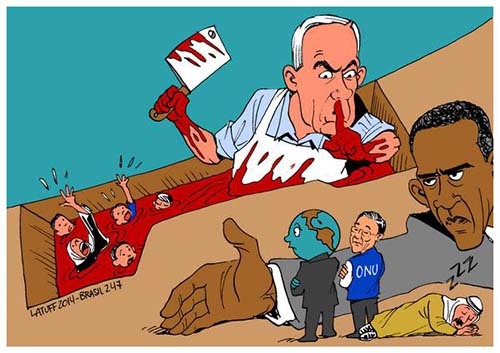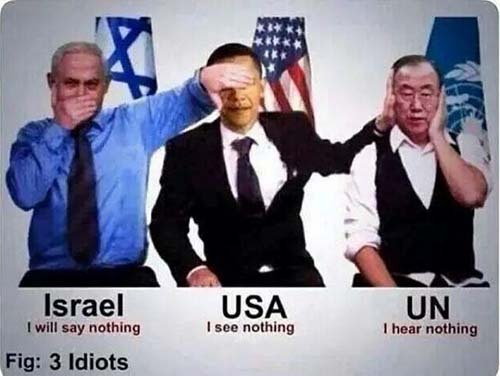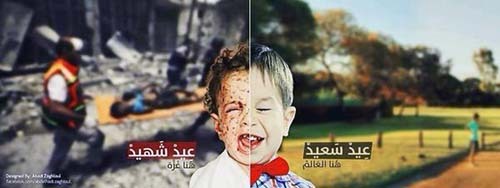The images from and about Gaza disseminated through social media are striking, searing, poignant and loaded with messages, proving, yet again, that a picture (or cartoon) is worth a thousand words.
They range from neutral to graphic traditional media photos shot at the scene of events, alongside images from "citizen journalists" documenting Israel's onslaught on the densely populated strip, where most of the victims have been unarmed civilians, to cartoons and comic pictures making the point in more hard hitting or ironic terms.

Potent Carlos Latuff cartoon depicting Israeli slaughter of civilians as
world stands idly by (courtesy Latuff)
Brazilian cartoonist Carlos Latuff, who pulls no punches, drew Israeli Prime Minister Benjamin Netanyahu butchering Palestinians in a pool of blood with one hand and asking spectators to shut up with the other.
The spectators are U.S. President Barack Obama holding back any help to the victims, as well as the world and United Nations Secretary General Ban Ki-Moon standing idly by, while dormant Arab leaders snore away amidst the mayhem.
That and other illustrations have gone viral since the latest outbreak of violence began, with Twitter acting as a speedy conduit through which to publish news and views.
In a variation on the world's inaction theme, campaigners took to the Twittersphere with a fake photo showing Netanyahu, Obama and Ban in a take on the three monkeys who speak, see and hear nothing, and a caption that reads "3 idiots."

Screen shot of "speak, see, and hear nothing"
Going a step further, Egypt's CBC TV channel tweeted that activists had launched a cartoon drive entitled "Save the Innocence in Palestine."
It imagined what famous cartoon characters would endure if they lived under Israeli control and one picture in the tweet showed a brutal Netanyahu hammering away at a broken and bleeding Pinocchio.

Screen shot of Netanyahu hammering at bleeding Pinocchio
The most moving (and rattling) depictions making social media rounds have been photos from traditional and other news sources of dead or bleeding babies and children cut down by weapons fired from Israeli ground, sea and airborne forces.
World Editors Forum and WAN-IFRA research fellow Julie Posetti asked whether social media were to blame for the publishing of increasingly graphic images in newspapers.
Social media platforms are the Wild West of publication. Journalists and traditional news publishers are no longer the primary information 'gatekeepers' of public discourse; neither are they able to impose their professional publication standards and ethics on social media users and bloggers. Instead, they are co-creators of content in the social media sphere.
A divided picture tweeted this week with half a boy's face smiling and the other half pockmarked by shrapnel wounds carried a message marking a Fitr feast greeting that ended the Muslim fasting month of Ramadan.
"Eid saeed (huna al aalam) - Eid shaheed (huna Ghazza)," the rhyming caption said. Translation: Happy feast (from the world), martyr's feast (from Gaza).

Screen shot of Eid Saeed - Eid shaheed tweet
With competition in a 24/7 news cycle at fever pitch, images can easily trip up legacy media reporters and editors.
According to Posetti, creators of user-generated content are sharing the public domain in debates about Gaza and other hotspots to grab various audiences' attention.
Under these conditions, adding proper sourcing and context within ethical parameters becomes increasingly difficult, but not necessarily impossible.
One such context is history, and comparing or contrasting events.
Remi Brulin, a research fellow at New York University, tweeted that Israeli pronouncements to the besieged Gaza population were straight out of the French colonial playbook in Algeria in the 1950s.

Screen shot of tweet on Gaza being equal to French
colonization of Algeria
He produced a message on a page from a book addressed to residents of an Algerian area in which the colonial power at the time warned people to either choose France's peace and protection or face "crime" (by not submitting) and inevitable subsequent punishment.
Our 2024 Coverage Needs You
It's Another Trump-Biden Showdown — And We Need Your Help
The Future Of Democracy Is At Stake
The Wartime Updates You Need To Know
Your Loyalty Means The World To Us
As Americans head to the polls in 2024, the very future of our country is at stake. At HuffPost, we believe that a free press is critical to creating well-informed voters. That's why our journalism is free for everyone, even though other newsrooms retreat behind expensive paywalls.
Our journalists will continue to cover the twists and turns during this historic presidential election. With your help, we'll bring you hard-hitting investigations, well-researched analysis and timely takes you can't find elsewhere. Reporting in this current political climate is a responsibility we do not take lightly, and we thank you for your support.
Contribute as little as $2 to keep our news free for all.
Can't afford to donate? Support HuffPost by creating a free account and log in while you read.
The 2024 election is heating up, and women's rights, health care, voting rights, and the very future of democracy are all at stake. Donald Trump will face Joe Biden in the most consequential vote of our time. And HuffPost will be there, covering every twist and turn. America's future hangs in the balance. Would you consider contributing to support our journalism and keep it free for all during this critical season?
HuffPost believes news should be accessible to everyone, regardless of their ability to pay for it. We rely on readers like you to help fund our work. Any contribution you can make — even as little as $2 — goes directly toward supporting the impactful journalism that we will continue to produce this year. Thank you for being part of our story.
Can't afford to donate? Support HuffPost by creating a free account and log in while you read.
It's official: Donald Trump will face Joe Biden this fall in the presidential election. As we face the most consequential presidential election of our time, HuffPost is committed to bringing you up-to-date, accurate news about the 2024 race. While other outlets have retreated behind paywalls, you can trust our news will stay free.
But we can't do it without your help. Reader funding is one of the key ways we support our newsroom. Would you consider making a donation to help fund our news during this critical time? Your contributions are vital to supporting a free press.
Contribute as little as $2 to keep our journalism free and accessible to all.
Can't afford to donate? Support HuffPost by creating a free account and log in while you read.
HuffPost is dedicated to covering the devastating war between Hamas and Israel. We've broken news on the famine in Gaza, the State Department's turmoil, as well as what Hamas is thinking now — and we're far from done. HuffPost is committed to bringing you the critical updates you need to know. Would you consider contributing as little as $2 to support our reporting? Thank you for your support.
Can't afford to donate? Support HuffPost by creating a free account and log in while you read.
Dear HuffPost Reader
Thank you for your past contribution to HuffPost. We are sincerely grateful for readers like you who help us ensure that we can keep our journalism free for everyone.
The stakes are high this year, and our 2024 coverage could use continued support. Would you consider becoming a regular HuffPost contributor?
Dear HuffPost Reader
Thank you for your past contribution to HuffPost. We are sincerely grateful for readers like you who help us ensure that we can keep our journalism free for everyone.
The stakes are high this year, and our 2024 coverage could use continued support. If circumstances have changed since you last contributed, we hope you'll consider contributing to HuffPost once more.
Already contributed? Log in to hide these messages.





